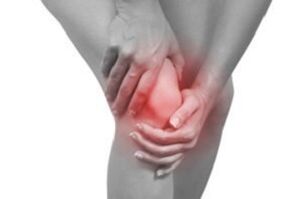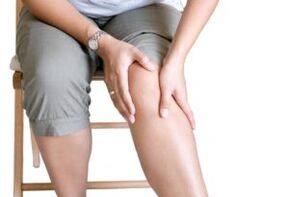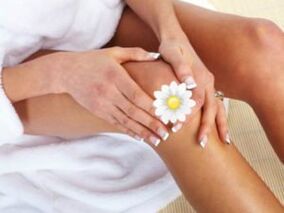
Of all the joints in the human body, knee pain is the most common complaint of humans. The knee joint is complex, it can withstand a lot of load during different types of physical activity, so there can be many reasons for pain in it. Knee pain, even if it occurs occasionally and disappears on its own, should not go unnoticed.
Knee pain, regardless of intensity, significantly impairs quality of life. There is no joy from your favorite outdoor activities, efficiency decreases, and simply going shopping becomes a problem.
In our article we will consider what to do if your knee joints hurt, how to treat them and whether it is possible to get rid of knee discomfort forever - the last question is especially relevant for older people who think about sedentary movement and joint pain.
Diagnosis of pain
- The nature of the pain needs to be determined. The pain can be sharp, burning, stinging, aching.
- Eliminate the circumstances of pain - at night, after exertion, while walking, in the morning, sudden sharp pain.
- Were there any other signs of joint damage: swelling, hyperemia (redness), joint deformity, creaking, limited mobility.
- Check for a history of infection, stress, leg injuries, or increased physical activity.
- Pass the instrumental examination in the medical-preventive institution (LPU) - blood test, X-ray diagnosis, synovial fluid analysis.
Causes of knee pain
There are more than 200 joint pathologies, most of which are accompanied not only by pain. Only on the basis of a complex of symptoms and examinations can you determine what makes your knees hurt.
Traumatic pathology
In traumatic pathologies, knee pain occurs in joint injuries (bumps, falls, prolonged stress on the joints - typical for athletes) or in general diseases of the body.
Consider the main traumatic pathologies.
Knee fracture
Fracture or displacement of the patella, fractures of the condyle of the femur and / or tibia. When you fall from a height to your knees, in case of traffic accidents, etc.
The victim experiences sharp severe pain at the time of the stroke, the pain does not stop over time, may weaken slightly, but is intensified by pressure or walking.
The joint swells, deforms, fills with blood (hemarthrosis), the knee does not bend, and the patella becomes abnormally mobile.
Dislocated knee

It is characterized by the displacement of the joint bones relative to each other. Dislocation of the knee joint is of different complexity (complete, incomplete, complicated by soft tissue rupture, etc. ).
Common dislocation occurs as a result of a knee injury or as a result of a congenital anomaly: weakness or excessive elasticity of the ligaments, flat sliding paths of the femur in the joint, excessively high position of the patella.
A sprained knee joint is a pretty serious injury and if not taken care of in time, it can all end in serious complications. Knee dislocation is the most painful of all types, although it is rare.
Serious injuries such as sprains should be treated in healthcare facilities, so there should be no stand-alone intervention. That's what traumatologists do.
Sprains, tendon ruptures, ligaments
Depending on the degree of damage (partial rupture of individual fibers, incomplete tearing, complete rupture), symptoms appear: creaking and clicks when moving, bruising below the rupture site, limited flexion-extension of the joint, knee swelling, joint reversibility (with complete ligament rupture). The pain is sharp and strong, but with a minor injury, it may not appear immediately, but after some time.
Bursitis
Inflammation of the periarticular bursa due to trauma, infections, metabolic disorders, autoimmune diseases. It often occurs in athletes and people with increased body weight. The knee swells, the pains are of varying intensity, but intensify with exertion and at night.
Bursting of the meniscus
It may be due to trauma or degenerative changes in cartilage tissue. Acute trauma is characterized by severe pain, swelling, and limited mobility. The symptoms of degenerative changes are mild.
Diseases of the joints
Knee pain can be a symptom of a medical condition.
We wrotemost common diseases with knee pain syndrome:
Rheumatism
Diagnosis is much rarer than in the 19th and 20th centuries. This is due to the discovery of penicillin (and then the production of other antibiotics), but also due to low diagnostic possibilities in the past, when almost all joint diseases were attributed to rheumatism.
A characteristic sign of rheumatism is alternating pain in the joints: first one joint becomes inflamed, then the other. For example, the pain in the knee subsides, but occurs in another large joint (elbow, hip).
Rheumatism is more common in children and adolescents, the disease develops after streptococcal infection of the upper respiratory tract.
Note: Advanced rheumatism leads to damage to the heart (rheumatic heart disease) or the nervous system (Korea).
Reactive arthritis
It is more common in people of reproductive age, because inflammation of the joints is most often caused by pathogenic microbes that sexually enter the human body.
Much less often, reactive arthritis is caused by an infection of the gastrointestinal tract or infectious inflammation of the nasopharynx (sore throat, flu). 1-4 weeks after the illness, the patient notices that his legs started to hurt at night.
Both large joints (knees, ankles) and small (big toe pain or aches) can become inflamed and painful. Knee pain is accompanied by swelling and / or redness.
Sometimes symptoms include conjunctivitis (inflammation and pain in the eyes), keratoderma (thickening of the skin on the soles).
Reiter's syndrome
Urethritis (frequent, painful urination) and intestinal disorders are associated with the symptoms of ordinary reactive arthritis.
Osteoarthritis
Diseases of the elderly. Occasionally my knees hurt at night "because of the weather". Joint strain (long walks) increases pain, swelling and reduces joint mobility.
After resting and warming up, the pain disappears.
Baker's cyst
Swelling in the back of the knee, which causes a feeling of tightness, difficulty moving.
Osteochondritis dissecans (Köning's disease)
The cartilage that covers the bone peels, the painful knee hurts, and when the fragment is completely peeled off, the movement of the joint is difficult.
Osgood-Schlatter disease
It is more commonly diagnosed in adolescents. Knee pain intensifies when climbing and descending stairs, squatting.
Rheumatoid arthritis
An autoimmune disease whose mechanism is unclear. It is noticed that the initial circumstances are a common list of burdens on the immune system: from stress and infection, to hypothermia. Immune bodies that attack their own cells cause inflammation of the joint, especially its synovium.
Under the influence of the attack of immune cells, the membrane swells, increases in volume, and then begins to grow into the nearby cartilage and bone tissue. The result of the process is pain in the knee joints, which becomes unbearable in the second half of the night.
The disease lasts for years, the treatment consists of non-steroidal anti-inflammatory drugs, corticosteroid hormones, gold preparations, immunosuppressants, anti-malarial drugs.
It occurs due to improper metabolism. Due to the abuse of alcohol, "purine" products (meat, dried meat, pickles).
Uric acid produced in the blood is deposited in the joints in the form of sodium urate crystals. Increasing "deposits" gradually affect the mobility of the joint, strong attacks of pain appear, the time interval between attacks gradually decreases.
Vascular pain in the knees is characterized by a feeling of pulling along the vein, sometimes patients notice an acute burning sensation.
Only a doctor, after a detailed examination, can say why the knee hurts, if there was no obvious injury. It is unreasonable to rub the knee joint with a product that "helped the neighbor". After all, what helps treat a joint injury can cause a deterioration in the autoimmune mechanism of the disease.
Treatment of knee pain
The doctor chooses the treatment regimen depending on the diagnosis.
Therapeutic measures are aimed at combating:
- with the cause of the disease - infection, tumor, abnormal metabolic processes, failure of the immune system.
- with pain syndrome - symptomatic treatment includes painkillers, intra-articular blockade.
- with degenerative processes - drugs with chondroprotectors help to restore the cartilaginous tissue of the joint.
If necessary, resort to surgery, endoprosthetics, use physiotherapy and therapeutic exercises for the joints.
Pain relief products
Checklist for those who have knee pain - what to do to alleviate the condition.
> zxtable border = "1" cellpadding = "0" >Severe joint pain is relieved by nonsteroidal anti-inflammatory drugs (NSAIDs).
But most patients (obese people, age-related changes in the joints) would not have to think about what to do with the pain if they adhere to a preventive minimum:
- Proper nutrition with sufficient calcium, vitamins, the fight against excess weight;
- Reduction of severe stress on the wrist to a change of job, if it consists of a full day of "standing on your feet";
- Systematic physical therapy to strengthen muscles and ligaments - a good muscular corset reduces the load on the bones;
Joint diseases can develop over the years and lead to a significant deterioration in quality of life. A timely visit to the doctor and an arsenal of folk remedies will help keep the joy of moving to old age.
Treatment of joints at home - folk recipes
Homemade recipes for ointments and coatings based on natural ingredients are used in courses - the only way you can achieve a lasting result.
7 simple folk remedies for knee pain:
- Cabbage leaves. Cuts are made on the fresh leaf so that the juice comes out. Put a spoonful of honey in the middle and put this "compress" on your knee. The leaf is fixed with a bandage. Wear a bandage all day or perform the procedure at night. Burdock and plantain leaves are used in a similar way.
- Propolis tincture for arthritis. If your knees "twist" at night (the causes of dull pain can range from changing weather to stress on your legs), lubricate your wrist with the mixture, rubbing it into your skin until it dries. If the knees are very sore, then make a complete compress: moisten the soft tissue with tincture and apply it to the wrist, cover it with a film and wrap a scarf. The tool is also used to warm the joint if the sore knee has cooled. They also use tinctures of natural stimulants: aloe, kalanchoe, mummy, dead bees.
Important:biologically active substances cannot be used if the disease is autoimmune in nature. Stimulants activate the immune system and worsen the disease.
- Gelatin compress. A piece of gauze soaked in hot water is squeezed out, 1 teaspoon is poured in the middle. gelatin, applied to the wrist, wrapped in cling film and wrapped. Repeat the procedure 14 days in the evening. The product stimulates joint nutrition and cartilage regeneration.
- A mustard compress will help if your knee hurts a lot. Take honey and dry mustard in equal proportions, add warm water and salt until a mushy consistency is formed. Lubricate the knee with the mixture, lay a cloth with a film and bandage. Exposure time 20-40 min. , Remove in case of severe stinging. Mustard compresses are used for pain every other day.
- To prevent pain in the legs, prepare a drug for oral administration: the gelatin is diluted in 0. 5 liters of water in the evening, heated in the morning until completely dissolved. The mixture is taken before meals by ¼ - 1/2 cup, drink for a month.
- Internal goat ointment (100 g) is mixed with "Zvezdochka" balm (1 jar), the resulting ointment is rubbed for venous and joint pain in the knee.
- Kefir mask. 0, 5 liters of kefir crumble bread, add 1 tbsp. soda. The mixture is insisted for 6 hours. Then the liquid is filtered, moistened with gauze and compresses are made overnight for several days, until the pain disappears.

It is recommended to regularly apply home remedies with folk remedies, combining traditional medicine and modern methods. Do not wait for the disease to establish itself firmly and declare severe pain, deformity of the joint. Going to the doctor early will speed up your recovery, while the chronic form of the disease is more difficult to cure.
Note:treatment with folk remedies is allowed only with the approval of a doctor, after examination and diagnosis.

















































